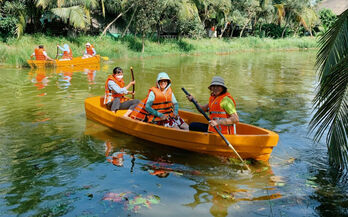
Eco-tourism is developed in Dong Thap province. (Photo: VNA)
Such models help to protect the environment, promote local culture, lengthen value chains, raise farm produce values and generate jobs for rural residents.
One of the examples is Sa Dec flower village in Sa Dec city, where local residents are encouraged to upgrade infrastructure and offer services to attract visitors.

A corner of Sa Dec flower village (Photo: VNA)
Covering an area of 313ha, the village is home to more than 2,000 types of flowers, bonsai trees, and ornamental trees from different regions of Vietnam.
The village now has dozens of households offering tourism services and homestays like Happy Land Hung Thy, Bamboo House Homestay, and Ngọc Lan flower observatory tower.
Meanwhile, Lai Vung district is well known for its citrus farms that have helped to double income of local residents as compared with traditional farming models. Currently, nine citrus farms in the district are opening doors to tourists.
Tourists from Ho Chi Minh City and adjacent localities have also flocked to Dong Thap during weekends and holidays for boat trips around immense lotus ponds and special cuisines made from lotus.

Illustrative image (Photo: VNA)
Apart from investment in infrastructure, Dong Thap has encouraged local people to engage in tourism startups in combination with digitalisation. It is working to bring into full play advantages in waterway and eco-tourism, while paying attention to natural conservation.
Total revenue from community-based tourism areas between 2016 and 2020 was more than 43 billion VND (1.88 billion USD).
Community-based tourism has also helped Dong Thap rank number three in the number of tourists in the Mekong Delta region./.
VNA






